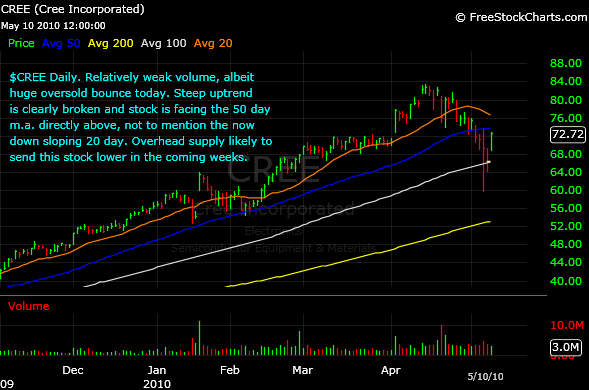Ever since March 2009, virtually every time that we have had a market correction it seems as though we have been on the verge of ending the bull run and starting a new phase of the bear market. Often times, however, just as it seemed as if the bears were about to push the broad indices down through their respective 200 day moving averages, the market would stop on a dime and proceed to sharply turn up on low volume and make new highs.
This phenomenon has been especially frustrating to many traders who were not already fully invested, because they never really got a good chance to reenter. Many technical traders, in particular, missed out on a lot of those moves higher because they either sat out or decided to go short. Needless to say, they either missed out on some big profits, or lost a lot of capital trying to go short (or both). Indeed, the correct play was to simply go along for the ride and chalk the whole thing up to us climbing the “wall of worry” that the early to middle stages of bull markets are so famous for. It was also correct to dismiss the low volume rallies as being due to the fact that we had a huge gap/vacuum/void to fill from the crash of 2008, which had alleviated a significant amount of selling pressure.
At the beginning of this month, however, several key indices and sectors had recovered many or all of the losses from pre 2008 crash levels. Because of that fact, the notion of ignoring the low volume on rallies has become less and less valid. Beyond that, many key leading stocks since 2009 have either become too extended, or have broken down on heavy selling volume.
One trend I am noticing amongst traders is that they have grown so frustrated with trying to short technically weak charts, that they are now using what would normally be their own sound analysis as a contrary indicator. Instead of going short, they think “I really got squeezed hard the last few times I tried shorting this stock that was up against heavy resistance after a weak volume rally. So, this time I will go long, even though I know this is a short.”
That kind of thinking can be very dangerous for several reasons. First off, as I noted before, the market has now effectively filled most or all of the huge gap created by the 2008 crash, so the drift up unsupported by volume argument is weaker than before. Next, to use your own sound technical analysis as a contrary indicator is a mistake because you are allowing the market to throw you off your game–or effectively put you “on tilt.” The phrase, “on tilt” is a common term used in the poker world, whereby a player loses his cool and changes his playing style for the worse due to a multitude of reasons.
One example of going on tilt would be if you are dealt pocket kings before the flop in a Texas Hold ’em poker game. You raise, and an opponent goes all-in. You ponder if your opponent has pocket aces (the only hand that has you beat), but eventually you correctly call, as your opponent turns up pocket queens, meaning you are a huge favorite to win. When the dealer flips a queen on the board with no king in sight, you lose all of the money you had in front of you. Despite the painful short term result, you made the correct long term decision. In other words, if you keep making that same decision over the long run, it will be profitable. The odds of another (regular playing) opponent having pocket aces in that situation are not great enough to compel you to fold.
However, you become extremely frustrated from the short term result and think, “Well, if I cannot win playing good cards and making good decisions, then the hell with it. I am going to gamble it up and play whatever crappy cards I want.” It is exactly this kind of emotional, knee jerk response that causes otherwise good poker players to go on tilt, and to go broke.
In the stock market, not making those same knee jerk trading decisions based on painful short term results is equally as important, so long as you are making the technically sound decision that is profitable over the long run.
Comments »














